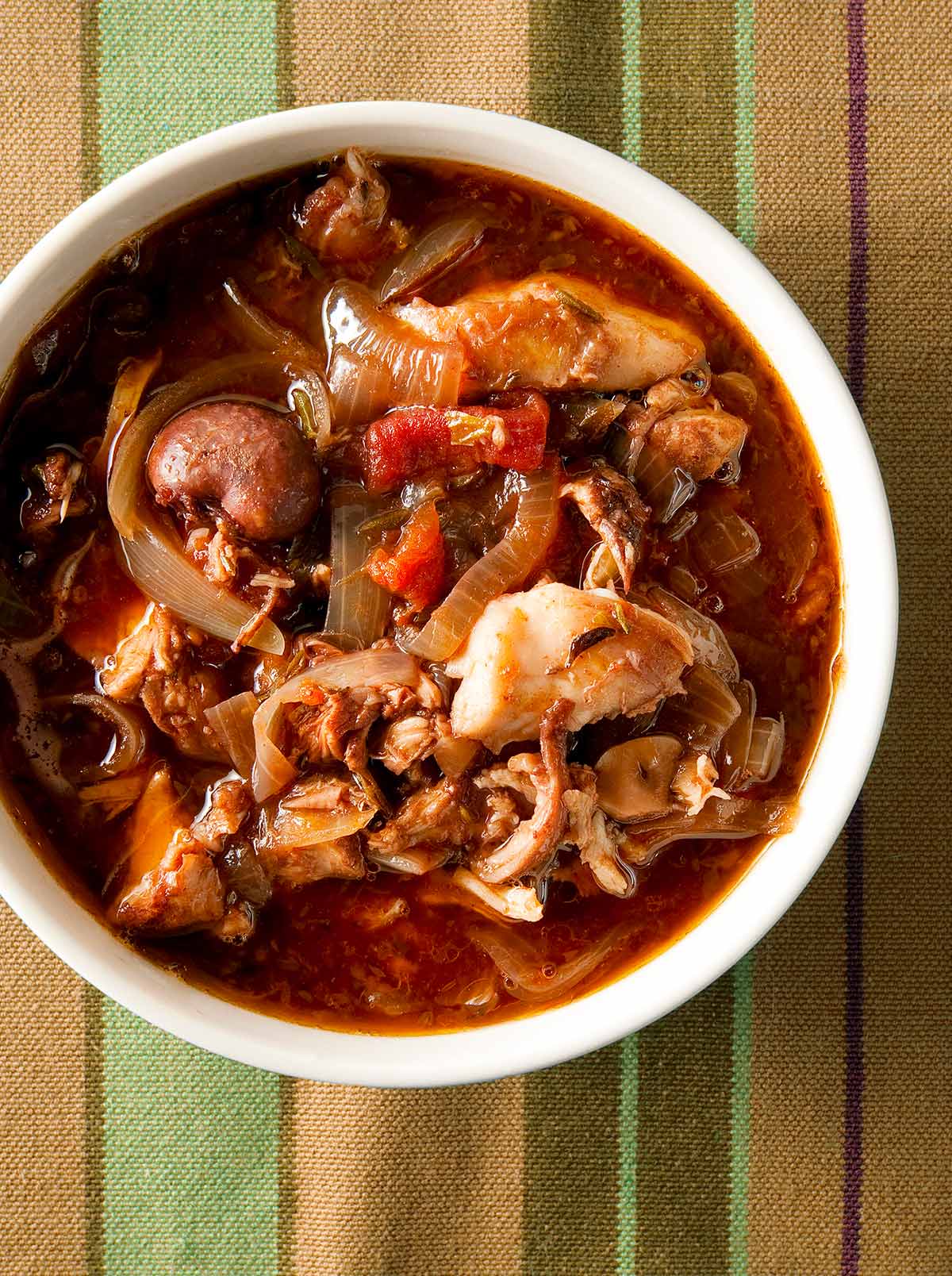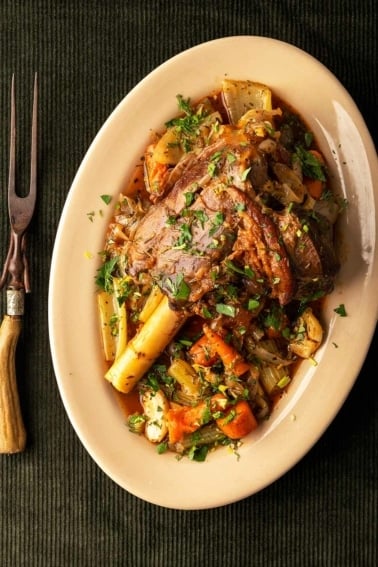As an Amazon Associate I earn from qualifying purchases.
Stifado is truly a classic of Greek cuisine. I have read at least a dozen different recipes for it, and this one is a rabbit stifado, called kouneli stifado in Greek. You see a beef stifado a lot, too, but that is a different dish.

In the case of stifado (stee-FAH-do), debate centers on the tomatoes and wine. Simple chopped tomatoes? Or tomato paste and crushed tomatoes? Red wine or white? Sweet or dry? I use both, largely because I live in Sacramento and have access to the incomparable Greek sweet wine Mavrodaphne. Without Mavrodaphne my rabbit stifado is a shadow of itself, although you can use Port in a pinch.
What does rabbit stifado taste like? The Orient, in its classical sense. It must have been quite the treat when it was invented, most likely in the Middle Ages when Greece was under Venetian rule. Any combination of sweetness with exotic spices such as cinnamon and allspice in an otherwise savory dish screams 1300 or 1400 to me.
Stifado uses a lot of olive oil, so it is smooth going down. This moistens the rabbit as well, which is braised slowly until it is about to fall off the bone. You can pull the meat off the bone before serving, as I do, or just leave the pieces in the stew. The Greeks typically leave the pieces as-is.
The spices give the stew zing without heat, and the tomatoes, which are obviously a post-1492 addition, add a bit more sweetness as well as needed acidity. There’s a reason stifado is such a strong part of Greek cooking.
You’ll want either a nice Greek red wine, a lager beer, or ouzo with a glass of water as a chaser to go along with this stew. And don’t forget to have lots of good crusty bread around, too.
If you want to make this part of a Greek feast, try starting with my favorite Greek fish recipe, and maybe serve Greek venison shanks after this stew.
Greek Rabbit Stew. Kouneli Stifado
Ingredients
- 2 cottontail rabbits or 1 domestic rabbit
- Kosher salt
- 2 medium red onions, sliced
- 5 cloves chopped garlic
- 10 allspice berries
- 1 cinnamon stick
- 4 bay leaves
- 1 tablespoon dried oregano
- 2 tablespoons tomato paste
- 4 large tomatoes, grated, or 1 14-ounce can of crushed tomatoes
- 1 cup dry red wine
- 1/2 cup sweet red wine
- 1/2 cup chicken or rabbit stock
- 1/4 cup red wine vinegar
- Freshly ground black pepper
- 1/4 cup olive oil
Instructions
- Cut up the rabbits and cut into serving pieces. Be sure to include little bits, like the belly flaps, the front legs, the kidneys and such; they become yummy surprises in the finished stew. Salt the rabbit pieces well and set aside for 30 minutes.
- Heat 1/4 cup olive oil in a frying pan and brown the rabbit well. As each piece browns, move it to a brazier or Dutch oven or other heavy, lidded pot. When the rabbit is browned, sauté the onions for 4 to 5 minutes over medium-high heat, until they begin to brown. Add the garlic and sauté for another minute. Sprinkle with salt. Do not let the garlic burn.
- Turn the contents of the frying pan into the brazier or a Dutch oven, then arrange the bay leaves, oregano, allspice berries and cinnamon stick over them.
- In the pan you browned the rabbit and the onions, add the wine, sweet wine, vinegar, stock, tomato paste and grated tomatoes — cut tomatoes in half and run them through your coarsest grater to leave the skins out of your pot. Cook this down over high heat for 3 to 4 minutes, then pour over everything in the pot.
- Cover the pot and bring to a simmer. Cook slowly for 1 hour, then check. It may need up to another hour. You want the rabbit to be just about falling off the bone. You can pull the rabbit meat off the bone, as I do, or just let your guests do that. Grind some black pepper and drizzle some really good olive oil over everything right when you serve.
Notes
Keys to Success
- Brown the rabbit really well. Take your time. It makes a difference in the finished stew.
- Include the sweet wine (Mavrodaphne if you can find it), as well as allspice and cinnamon. If you can't find Greek Mavrodaphne, which is highly likely, use Port or any other sweet red wine.
- Like many stews, this one is best a day or two after you make it. It will keep a week in the fridge.
Nutrition
Nutrition information is automatically calculated, so should only be used as an approximation.





I think I had this recipe in Greece last spring. it was a restaurant up in the mountains in a town near the ruins at Delphi, so frickin good. man, I might have to drag my shotgun out to the desert for some cottontails so I can try this out. Thanks for posting, Hank. You are definitely The Man, when it comes to game recipes.
OMG. This was AMAZING. Apparently I’m a sucker for late medieval flavour profiles because I loved this. As did my whole family. I reduced the liquid some after and served it on a plate over “Greek” fried rice and a Greek salad. Sooooooo good. The rabbit was super tender and the sauce was truly wonderful. This is a very comforting and warming dish and is perfect for when the weather turns cold. Many thanks!
Excellent! Thank you for sharing! I am from Greece and this was the best Kouneli Stifado!
Hi Hank,
in the recipe, you state that the tomatoes are a post 1492 addition. I have a child who cannot eat tomatoes. Is there anything that can be substituted for the tomatoes?
Nate: You would just leave them out in this case. Maybe add a little vinegar to keep things tart.
Hi Hank
You’re reciepe is as authentically Greek as any of my Greek relatives have grown up with, except most have used hare instead. I prefer yours with rabbit!!!
Awesome!!!
Chris
Thank you for this recipe! We just butchered five of our Ohio “Silver Fox” rabbits today. I was searching for recipes and lo and behold, your recipes popped up! It was almost a nostalgic event. Our oldest, now 40 convinced me that we had to raise rabbits when she was 12 because of the ‘feed to meat ratio’. We lived in Downtown Berkeley at the time..She even went to the library and learned how to cure the rabbit pelts. .Many years have passed since then and many of our clan has migrated east, with us! We just recently started raising rabbits again. She came today to help butcher them. What a blessing.
I made this yesterday, removing the bone, shredding the meat and serving it today. Great!
I’ve used this recipe a couple of times now and it’s one of my favorites for rabbit. It can be improvised a little by adding chopped carrots and celery to the mix. I also debone the rabbit as it’s easier to serve and eat.
Love it, Folk should eat more Rabbit, I’tl help the planet!!!!!!
Made this while away in Greece, lovely authentic recipe and the wonderful aroma filled the house whilst it was cooking. I’m going to try it with chicken thighs now I’m home .
I lived in Athens for 3 years and often ate this at a local taverna during winter –
delicious.
This is a fantastic recipe and being Greek, I can say it is authentic stifatho!! Thank you!
This is our go-to recipe for introducing rabbit to family and friends. Most people give us sideways looks when we tell them we raise rabbits and eat them. Until they get a taste of this fantastic stew! Thanks for sharing all of your fabulous recipes.
Truly authentic deliciously Greek stifathou. I am Greek but live in southern Maine now. Delicious with rabbit and with venison or moose. thank you and efhatisto!!
Magnificent! The only substitution I made was ruby port for the Mavrodaphne (not readily available here). I cooked it on Monday and then refrigerated it until Thursday. Wow! Beautifully complex and rich but not heavy.
We have just eaten this dish tonight. I followed the recipe quite closely. An all round ‘excellent’ from the family – reminded us of Greece. Thank you.